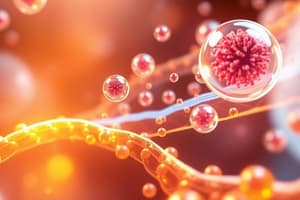Podcast
Questions and Answers
Which type of cell junction allows the transfer of cytoplasm and solutes between adjacent cells?
Which type of cell junction allows the transfer of cytoplasm and solutes between adjacent cells?
- Tight junctions
- Adherens junctions
- Gap junctions (correct)
- Desmosomes
The main function of absorption barriers in the body is to:
The main function of absorption barriers in the body is to:
- Provide structural support to the cell membrane
- Regulate the concentration of solutes in the extracellular fluid
- Facilitate the absorption of nutrients and other essential compounds
- Protect tissues and organs from harmful compounds (correct)
What is the primary function of desmosomes in tissues?
What is the primary function of desmosomes in tissues?
- To facilitate the transfer of materials between cells
- To anchor the cytoskeleton to the cell membrane
- To regulate the permeability of the cell membrane
- To provide structural support and enable cells to function as a unit (correct)
Which of the following is a characteristic of passive diffusion?
Which of the following is a characteristic of passive diffusion?
Which type of membrane protein is responsible for the selective permeability of the cell membrane?
Which type of membrane protein is responsible for the selective permeability of the cell membrane?
What is the primary function of the extracellular fluid in the body?
What is the primary function of the extracellular fluid in the body?
Which of the following statements about the cell membrane is true?
Which of the following statements about the cell membrane is true?
What is the primary function of transport proteins in the cell membrane?
What is the primary function of transport proteins in the cell membrane?
Which of the following components of the cell membrane is responsible for cell recognition and immunological functions?
Which of the following components of the cell membrane is responsible for cell recognition and immunological functions?
What is the primary function of epithelia?
What is the primary function of epithelia?
Which of the following statements about the structure of epithelia is true?
Which of the following statements about the structure of epithelia is true?
What is the role of cell surface receptors in the cell membrane?
What is the role of cell surface receptors in the cell membrane?
What is the primary function of the intermembrane space between adjacent epithelial cells?
What is the primary function of the intermembrane space between adjacent epithelial cells?
What is the primary role of the tight junctions that bind the cells in the epithelial layer?
What is the primary role of the tight junctions that bind the cells in the epithelial layer?
Which of the following best describes the asymmetric distribution of transport proteins on the cell membrane of epithelial cells?
Which of the following best describes the asymmetric distribution of transport proteins on the cell membrane of epithelial cells?
Which of the following best describes the structure of the lipid bilayer in the cell membrane?
Which of the following best describes the structure of the lipid bilayer in the cell membrane?
How do the characteristics of the epithelial cells vary across different tissues and organs?
How do the characteristics of the epithelial cells vary across different tissues and organs?
What is the primary function of the extracellular fluid that fills the intermembrane space between adjacent epithelial cells?
What is the primary function of the extracellular fluid that fills the intermembrane space between adjacent epithelial cells?
Flashcards are hidden until you start studying
Study Notes
Cell Junctions
- Gap junctions allow transfer of cytoplasm and solutes between adjacent cells.
Absorption Barriers
- Main function is to control the passage of substances, protecting underlying tissues and preventing unwanted absorption.
Desmosomes
- Primary function is to provide mechanical strength and stability by anchoring adjacent cells together.
Passive Diffusion
- Characteristic includes movement of molecules from high to low concentration without energy input.
Membrane Proteins
- Integral membrane proteins are responsible for selective permeability, regulating what enters and exits the cell.
Extracellular Fluid
- Functions to provide a medium for nutrient exchange, waste removal, and signaling between cells.
Cell Membrane
- A true statement: it is selectively permeable, allowing specific substances to pass while blocking others.
Transport Proteins
- Primary function is to facilitate the movement of ions and molecules across the cell membrane.
Cell Recognition
- Glycoproteins are components of the cell membrane responsible for cell recognition and immunological functions.
Epithelia
- Primary function is to form protective barriers, facilitate absorption, and enable secretion of substances.
Structure of Epithelia
- True statement: Epithelial tissue has polarity, with distinct apical and basal surfaces.
Cell Surface Receptors
- Role is to receive signals from the environment and initiate cellular responses.
Intermembrane Space
- Primary function is to maintain cell cohesion and regulate the movement of substances between epithelial cells.
Tight Junctions
- Role is to seal epithelial cells together, preventing leakage of materials and maintaining cell polarity.
Transport Protein Distribution
- Asymmetric distribution of transport proteins is crucial for directional transport across the epithelial cell membrane.
Lipid Bilayer Structure
- Described as a double layer of phospholipids with hydrophilic heads facing outward and hydrophobic tails facing inward.
Epithelial Cell Characteristics
- Vary across tissues and organs; adaptations include shape, function, and presence of specialized structures like cilia or microvilli.
Extracellular Fluid Between Epithelial Cells
- Fills the intermembrane space, providing a supportive environment and facilitating communication and nutrient exchange.
Studying That Suits You
Use AI to generate personalized quizzes and flashcards to suit your learning preferences.


